Edytowaliśmy plik “wp-config.php” niezliczoną ilość razy podczas konfigurowania zaawansowanych funkcji, poprawiania problemów z połączeniem z bazą danych lub ułatwiania lokalnego rozwoju.
Jest to jeden z tych plików, z którymi pracujesz, gdy musisz zagłębić się w działanie WordPressa. A kiedy już wiesz, gdzie szukać, praca z nim jest całkiem prosta.
Ten plik kontroluje niektóre z najważniejszych ustawień twojej witryny – takie jak dostęp do bazy danych, tryb debugowania i klucze zabezpieczeń. To jak ukryty panel sterowania, który sprawia, że twoja witryna działa płynnie.
W tym przewodniku pokażemy, jak bezpiecznie znaleźć i edytować plik `wp-config.php` przy użyciu różnych narzędzi. Będziesz w stanie dokonać potrzebnych zmian bez obawy o zepsucie czegokolwiek.
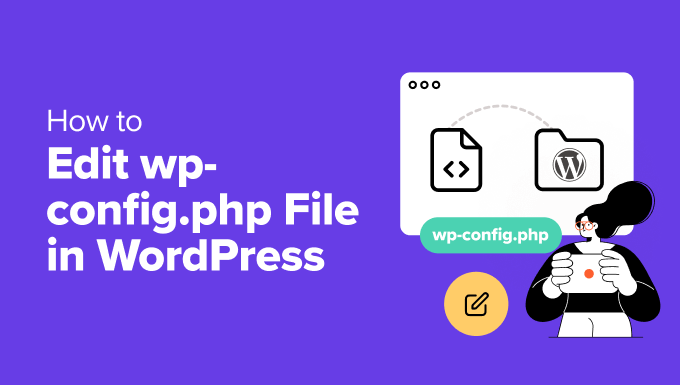
Oto lista tematów, które omówimy w tym przewodniku:
- What Is the wp-config.php File?
- Create a Backup Before You Edit wp-config.php 💾
- How to Access and Edit the wp-config.php File Safely
- Understanding the wp-config.php File
- MySQL Settings in wp-config.php File
- Authentication Unique Keys and Salts
- WordPress Database Table Prefix
- WordPress Debugging Mode
- Absolute Path Settings
- Useful wp-config.php Hacks and Settings
- Changing MySQL Port and Sockets in WordPress
- Changing WordPress URLs Using wp-config.php File
- Changing Uploads Directory Using The wp-config.php File
- Disable Automatic Updates in WordPress
- Limit Post Revisions in WordPress
- Video Tutorial
- Next Steps to Power Up Your WordPress Skills
Czym jest plik wp-config.php?
Plik `wp-config.php` jest ważną częścią każdej samodzielnie hostowanej witryny WordPress. Zawiera ważne ustawienia, które pomagają WordPressowi połączyć się z twoją bazą danych i działać płynnie.
Ten plik nie jest zawarty w domyślnym pliku do pobrania WordPress. Jest on tworzony automatycznie podczas procesu instalacji, gdy wpiszesz dane swojej bazy danych.
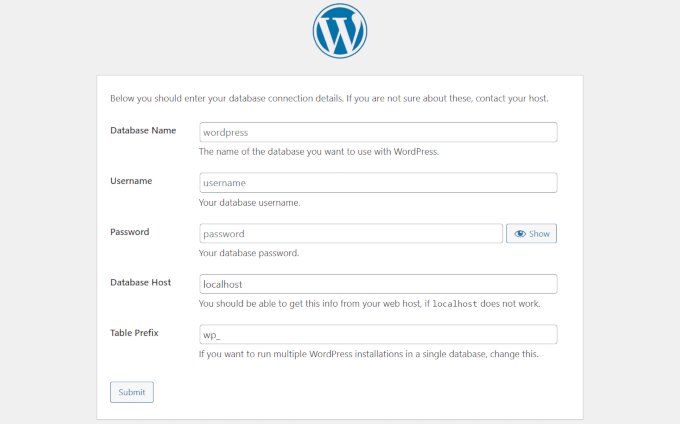
Bez poprawnych informacji w tym pliku, twoja witryna nie będzie w stanie połączyć się z bazą danych. Wtedy możesz zobaczyć przerażający komunikat “błąd nawiązywania połączenia z bazą danych”.
Wraz ze szczegółami bazy danych, plik ten może również zawierać ustawienia debugowania, klucze zabezpieczeń, limity pamięci i inne. Omówimy je w dalszej części artykułu.
Większość ludzi nie musi zbyt często dotykać pliku `wp-config.php`. Ale wiedza o tym, jak on działa – i jak go bezpiecznie edytować – daje większą kontrolę nad twoją witryną WordPress.
Jeśli tu jesteś, prawdopodobnie jesteś gotowy do wprowadzenia zmian. Przeprowadzimy Cię przez najbezpieczniejszy sposób edycji tego pliku bez powodowania kłopotów.
💡 Nie jesteś pewien, czy chcesz ryzykować uszkodzenie twojej witryny?
Jeśli czujesz, że utknąłeś lub jesteś zdenerwowany, skorzystaj z naszej awaryjnej pomocy technicznej WordPress. Za niewielką opłatą nasi inżynierowie WordPress wprowadzą zmiany bez zakłócania pracy Twojej witryny internetowej i klientów.
Utwórz kopię zapasową przed edycją wp-config.php 💾
Plik `wp-config.php` kontroluje kluczowe części twojej witryny WordPress i nawet mały błąd w nim może spowodować wyłączenie witryny.
Dlatego zawsze zalecamy utworzenie pełnej kopii zapasowej WordPress przed wprowadzeniem jakichkolwiek zmian.
Kopia zapasowa chroni twoją treść, ustawienia i pliki – i pozwala przywrócić wszystko, jeśli coś pójdzie nie tak.
Najlepszym sposobem na tworzenie kopii zapasowych WordPressa jest użycie Duplicatora. Jest to nasze rozwiązanie i najlepsza wtyczka do tworzenia kopii zapasowych WordPress dla większości użytkowników. Wystarczy kilka kliknięć, aby utworzyć kopię zapasową twojej witryny.
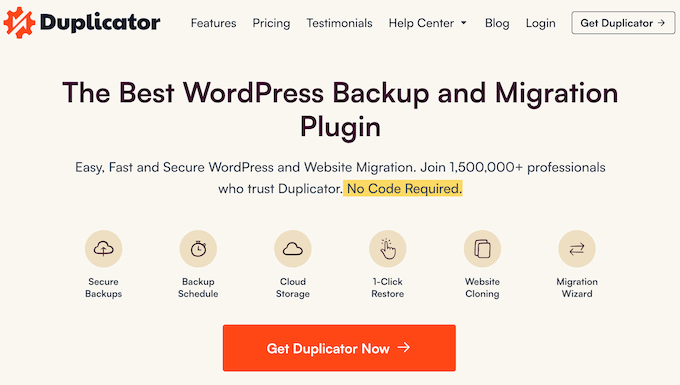
Uwaga: Dostępna jest również darmowa wersja aplikacji Duplicator. W przypadku funkcji takich jak zaplanowane kopie zapasowe i przechowywanie w chmurze zalecamy płatny plan.
Dlaczego polecamy Duplicator?
Polecamy Duplicator, ponieważ używamy go na naszych własnych witrynach internetowych, w tym WPBeginner, do tworzenia kopii zapasowych. To był przełom w zakresie zabezpieczeń i stabilności naszych witryn internetowych. Aby uzyskać więcej informacji, zapoznaj się z naszą pełną recenzją Duplicatora.
Jak bezpiecznie uzyskać dostęp do pliku wp-config.php i go edytować?
Plik `wp-config.php` znajduje się na twoim serwerze hostingowym WordPress, w katalogu głównym witryny.
Możesz uzyskać do niego dostęp, łącząc się z twoją witryną za pomocą klienta FTP lub Menedżera plików w panelu sterowania hostingu.
Zazwyczaj preferujemy FTP ze względu na większą kontrolę. W systemie Windows dobrze sprawdzają się narzędzia takie jak FileZilla, WinSCP lub SmartFTP. Użytkownicy komputerów Mac mogą wypróbować FileZilla, Transmit lub CyberDuck.
Zacznij od połączenia się z twoją witryną za pomocą klienta FTP. Będziesz potrzebował danych logowania do FTP, które są dostarczane przez dostawcę hostingu. Jeśli ich nie znasz, po prostu zapytaj zespół pomocy technicznej twojego hosta.
Po połączeniu otwórz katalog główny. Zobaczysz inne katalogi, takie jak wp-content, wp-includes i wp-admin – to tam znajduje się plik `wp-config.php`.
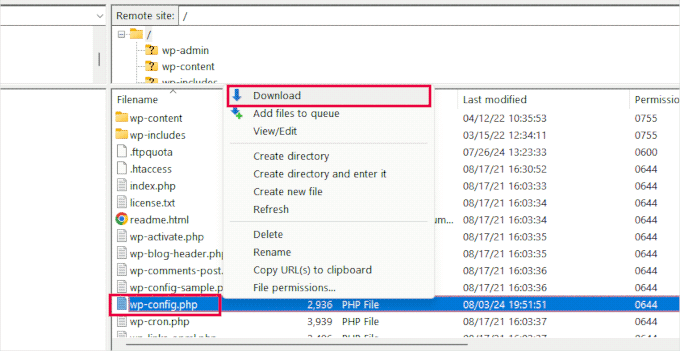
Kliknij plik prawym przyciskiem myszy i wybierz opcję “Pobierz”, aby zapisać go na twoim komputerze.
Następnie otwórz plik za pomocą zwykłego edytora tekstu, takiego jak Notatnik lub TextEdit. Używaliśmy obu – świetnie nadają się do prostych edycji.
Po wprowadzeniu zmian wróć do klienta FTP i prześlij plik do tego samego katalogu na twoim serwerze.
Twój klient FTP zapyta, czy chcesz nadpisać istniejący plik. Wybierz “Nadpisz” i kliknij OK, aby zakończyć przesyłanie.
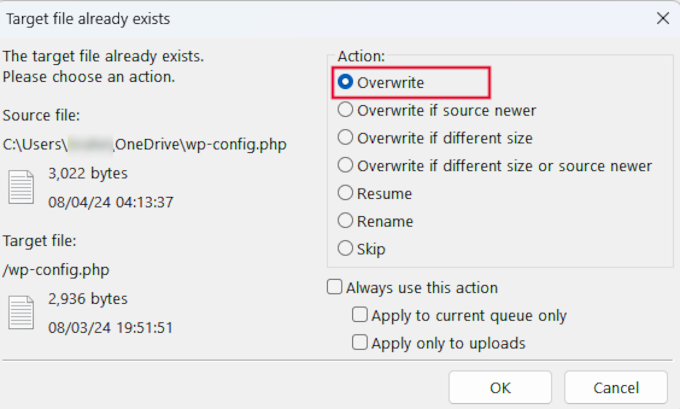
Zrozumienie pliku wp-config.php
Zanim zaczniesz, przeanalizujmy pełny kod domyślnego pliku wp-config.php. Możesz również zobaczyć próbkę tego pliku tutaj.
1 2 3 4 5 6 7 8 9 10 11 12 13 14 15 16 17 18 19 20 21 22 23 24 25 26 27 28 29 30 31 32 33 34 35 36 37 38 39 40 41 42 43 44 45 46 47 48 49 50 51 52 53 54 55 56 57 58 59 60 61 62 63 64 65 66 67 68 69 70 71 72 73 74 75 76 77 78 79 80 81 82 83 84 85 86 87 88 89 90 91 92 93 94 95 96 | <?php/** * The base configuration for WordPress * * The wp-config.php creation script uses this file during the installation. * You don't have to use the website, you can copy this file to "wp-config.php" * and fill in the values. * * This file contains the following configurations: * * * Database settings * * Secret keys * * Database table prefix * * ABSPATH * * @link https://developer.wordpress.org/advanced-administration/wordpress/wp-config/ * * @package WordPress */// ** Database settings - You can get this info from your web host ** ///** The name of the database for WordPress */define( 'DB_NAME', 'database_name_here' );/** Database username */define( 'DB_USER', 'username_here' );/** Database password */define( 'DB_PASSWORD', 'password_here' );/** Database hostname */define( 'DB_HOST', 'localhost' );/** Database charset to use in creating database tables. */define( 'DB_CHARSET', 'utf8' );/** The database collate type. Don't change this if in doubt. */define( 'DB_COLLATE', '' );/**#@+ * Authentication unique keys and salts. * * Change these to different unique phrases! You can generate these using * the {@link https://api.wordpress.org/secret-key/1.1/salt/ WordPress.org secret-key service}. * * You can change these at any point in time to invalidate all existing cookies. * This will force all users to have to log in again. * * @since 2.6.0 */define( 'AUTH_KEY', 'put your unique phrase here' );define( 'SECURE_AUTH_KEY', 'put your unique phrase here' );define( 'LOGGED_IN_KEY', 'put your unique phrase here' );define( 'NONCE_KEY', 'put your unique phrase here' );define( 'AUTH_SALT', 'put your unique phrase here' );define( 'SECURE_AUTH_SALT', 'put your unique phrase here' );define( 'LOGGED_IN_SALT', 'put your unique phrase here' );define( 'NONCE_SALT', 'put your unique phrase here' );/**#@-*//** * WordPress database table prefix. * * You can have multiple installations in one database if you give each * a unique prefix. Only numbers, letters, and underscores please! */$table_prefix = 'wp_';/** * For developers: WordPress debugging mode. * * Change this to true to enable the display of notices during development. * It is strongly recommended that plugin and theme developers use WP_DEBUG * in their development environments. * * For information on other constants that can be used for debugging, * visit the documentation. * * @link https://developer.wordpress.org/advanced-administration/debug/debug-wordpress/ */define( 'WP_DEBUG', false );/* Add any custom values between this line and the "stop editing" line. *//* That's all, stop editing! Happy publishing. *//** Absolute path to the WordPress directory. */if ( ! defined( 'ABSPATH' ) ) { define( 'ABSPATH', __DIR__ . '/' );}/** Sets up WordPress vars and included files. */require_once ABSPATH . 'wp-settings.php'; |
Każda sekcja pliku wp-config.php jest dobrze udokumentowana w samym pliku. Prawie wszystkie ustawienia są zdefiniowane przy użyciu stałych PHP.
1 | define( 'constant_name' , 'value'); |
Przyjrzyjmy się bliżej każdej sekcji w pliku wp-config.php.
Ustawienia MySQL w pliku wp-config.php
Twoje ustawienia połączenia z bazą danych WordPress znajdują się w sekcji “Ustawienia bazy danych” w pliku wp-config.php.
Będziesz potrzebował twojego hosta MySQL, nazwy bazy danych, nazwy użytkownika bazy danych i hasła, aby wypełnić tę sekcję.
1 2 3 4 5 6 7 8 9 10 11 12 13 14 15 16 17 18 | // ** Database settings - You can get this info from your web host ** ///** The name of the database for WordPress */define( 'DB_NAME', 'database_name_here' );/** Database username */define( 'DB_USER', 'username_here' );/** Database password */define( 'DB_PASSWORD', 'password_here' );/** Database hostname */define( 'DB_HOST', 'localhost' );/** Database charset to use in creating database tables. */define( 'DB_CHARSET', 'utf8' );/** The database collate type. Don't change this if in doubt. */define( 'DB_COLLATE', '' ); |
Oto lista stałych w tej sekcji i ich działanie.
| Constant Name | Description |
|---|---|
| DB_NAME | The name of the database for WordPress. |
| DB_USER | The username used to access the WordPress database. |
| DB_PASSWORD | The password for the database username. |
| DB_HOST | The hostname of the database server (usually ‘localhost’). |
| DB_CHARSET | The hostname of the database server (usually ‘localhost’). |
| DB_COLLATE | The collation type for the database (usually left blank). |
Do wypełnienia tych wartości potrzebne będą informacje o bazie danych, które można znaleźć w panelu sterowania twojego konta hostingowego.
W zależności od dostawcy hostingu, twój panel sterowania może wyglądać nieco inaczej niż na poniższych zrzutach ekranu. W takim przypadku należy poszukać sekcji “Bazy danych” na twoim koncie hostingowym.
Na przykład, jeśli korzystasz z Bluehost, najpierw zaloguj się na swoje konto hostingowe. Następnie kliknij “Ustawienia” pod twoją witryną internetową.
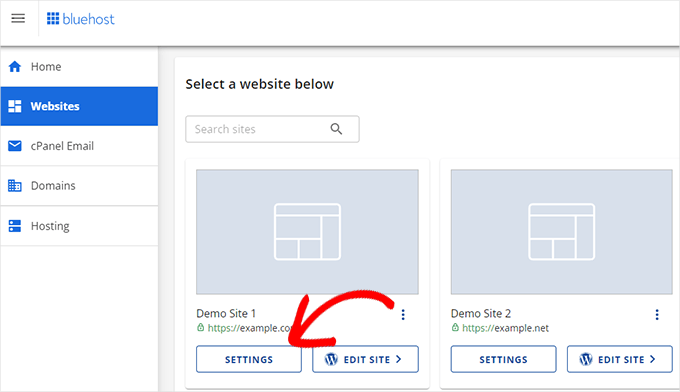
Spowoduje to wyświetlenie różnych ustawień Twojej witryny internetowej.
Przejdź do karty Zaawansowane, a następnie kliknij “Zarządzaj” obok sekcji “cPanel”.
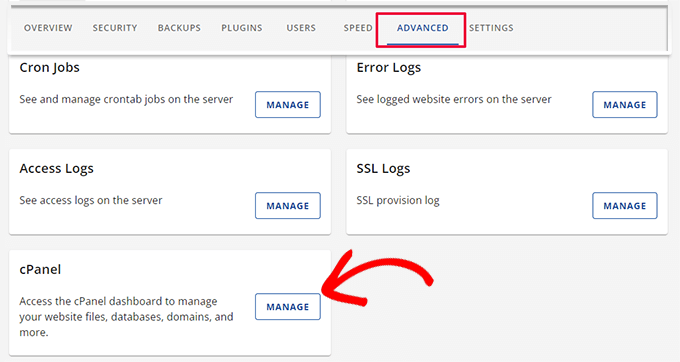
Spowoduje to otwarcie interfejsu cPanel w nowej karcie przeglądarki.
Następnie należy przewinąć do sekcji “Bazy danych” i kliknąć “Bazy danych MySQL”.
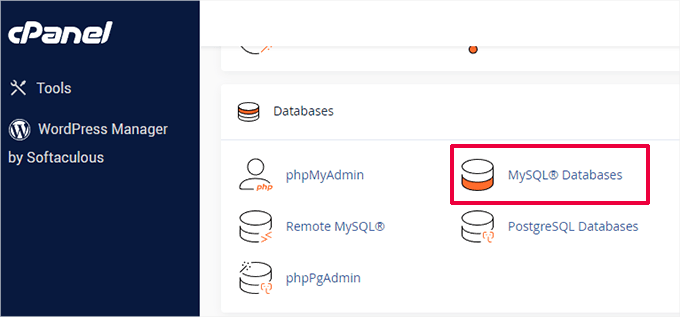
Na stronie Bazy danych MySQL znajdziesz listę twojej obecnej, aktualnej bazy danych, nazwę użytkownika i hasło.
Jeśli nie możesz znaleźć swojej bazy danych WordPress lub nazwy użytkownika i hasła MySQL, musisz skontaktować się ze swoim hostingiem.
Czym są DB_CHARSET i DB_COLLATE w pliku wp-config.php?
Ustawienie “DB_CHARSET” określa zestaw znaków dla twoich tabel bazy danych WordPress. Domyślnie jest to utf8, który obsługuje większość języków i zapewnia szeroką kompatybilność.
Ustawienie “DB_COLLATE” określa sposób sortowania i porównywania znaków przez bazę danych.
Zalecamy pozostawienie tego pola pustego i zezwolenie MySQL na użycie domyślnego sortowania dla określonego zestawu znaków (utf8_general_ci dla utf8).
Uwierzytelnianie unikatowe klucze i sole
Klucze i sole uwierzytelniające to funkcje zabezpieczeń w pliku wp-config.php. Dodają one dodatkową ochronę do twojej instalacji WordPress, zapewniając silne szyfrowanie informacji przechowywanych w plikach ciasteczek użytkownika.
1 2 3 4 5 6 7 8 9 10 11 12 13 14 15 16 17 18 19 20 21 | /**#@+ * Authentication unique keys and salts. * * Change these to different unique phrases! You can generate these using * the {@link https://api.wordpress.org/secret-key/1.1/salt/ WordPress.org secret-key service}. * * You can change these at any point in time to invalidate all existing cookies. * This will force all users to have to log in again. * * @since 2.6.0 */define( 'AUTH_KEY', 'put your unique phrase here' );define( 'SECURE_AUTH_KEY', 'put your unique phrase here' );define( 'LOGGED_IN_KEY', 'put your unique phrase here' );define( 'NONCE_KEY', 'put your unique phrase here' );define( 'AUTH_SALT', 'put your unique phrase here' );define( 'SECURE_AUTH_SALT', 'put your unique phrase here' );define( 'LOGGED_IN_SALT', 'put your unique phrase here' );define( 'NONCE_SALT', 'put your unique phrase here' );/**#@-*/ |
Łącznie dostępnych jest osiem różnych kluczy i soli. Każda para kluczy i soli to losowy, długi ciąg liczb tekstowych i znaków specjalnych.
Oto, co robi każdy klawisz:
| Constant Name | Description |
|---|---|
| AUTH_KEY | Authenticate cookies and ensure data integrity. |
| SECURE_AUTH_KEY | Secure the authentication cookie when using SSL. |
| LOGGED_IN_KEY | Validate logged-in cookies. |
| NONCE_KEY | Protect nonces (numbers used once) from being guessed. |
| AUTH_SALT | Adds extra security to the authentication process. |
| SECURE_AUTH_SALT | Adds extra security to the authentication process. |
| LOGGED_IN_SALT | Adds extra security to the logged-in process. |
| NONCE_SALT | Adds extra security to the nonce creation and verification process. |
Nowe klucze można wygenerować, przechodząc na stronę generatora kluczy prywatnych WordPress.org. Możesz je również zmienić później, jeśli podejrzewasz, że ktoś próbuje uzyskać dostęp do twojego obszaru administracyjnego WordPress.
Aby uzyskać więcej informacji, zapoznaj się z naszym przewodnikiem po kluczach zabezpieczeń WordPress.
Prefiks tabeli bazy danych WordPress
Domyślnie WordPress dodaje prefiks “wp_” do wszystkich tabel, które tworzy w bazie danych.
Zaleca się zmianę prefiksu twojej tabeli bazy danych WordPress na coś losowego podczas instalacji.
Utrudni to hakerom odgadnięcie twoich tabel WordPress i uchroni cię przed niektórymi typowymi atakami SQL injection.
1 2 3 4 5 6 7 | /** * WordPress database table prefix. * * You can have multiple installations in one database if you give each * a unique prefix. Only numbers, letters, and underscores please! */$table_prefix = 'wp_'; |
Ważne ⚠️: Należy pamiętać, że nie można zmienić tej wartości dla istniejącej witryny WordPress. Aby zmienić te ustawienia na istniejącej witrynie WordPress, postępuj zgodnie z instrukcjami w naszym artykule na temat zmiany prefiksu bazy danych WordPress.
Tryb debugowania WordPress
To ustawienie jest szczególnie przydatne dla użytkowników uczących się programowania WordPressa lub rozwiązywania błędów.
Domyślnie WordPress ukrywa powiadomienia generowane przez PHP podczas wykonywania kodu. Ustawienie trybu debugowania na “true” spowoduje wyświetlenie tych powiadomień.
Zapewnia to kluczowe informacje dla programistów w celu znalezienia błędów. Będzie to również pomocne, jeśli próbujesz rozwiązać problemy na witrynie WordPress.
1 2 3 4 5 6 7 8 9 10 11 12 13 | /** * For developers: WordPress debugging mode. * * Change this to true to enable the display of notices during development. * It is strongly recommended that plugin and theme developers use WP_DEBUG * in their development environments. * * For information on other constants that can be used for debugging, * visit the documentation. * * @link https://developer.wordpress.org/advanced-administration/debug/debug-wordpress/ */define( 'WP_DEBUG', false ); |
Można również zdecydować się na prowadzenie dziennika błędów i powiadomień.
Aby uzyskać bardziej szczegółowe instrukcje, zapoznaj się z naszym poradnikiem na temat włączania trybu debugowania w WordPress.
Ustawienia ścieżki bezwzględnej
Ostatnia część pliku wp-config definiuje ścieżkę bezwzględną. Ta instrukcja mówi WordPressowi, gdzie znaleźć rdzeń plików WordPressa.
Po tej instrukcji ABSPATH jest używana do wczytywania pliku wp-settings.php.
1 2 3 4 5 6 7 | /** Absolute path to the WordPress directory. */if ( ! defined( 'ABSPATH' ) ) { define( 'ABSPATH', __DIR__ . '/' );}/** Sets up WordPress vars and included files. */require_once ABSPATH . 'wp-settings.php'; |
Oba te ustawienia nie powinny być zmieniane.
Aby zrozumieć, w jaki sposób WordPress wczytuje pliki, zapoznaj się z naszym przewodnikiem po tym, jak WordPress działa za kulisami. Dowiesz się z niego krok po kroku, jak działa rdzeń oprogramowania WordPress.
Przydatne hacki i ustawienia wp-config.php
Do tej pory omówiliśmy domyślne ustawienia wp-config.php. Teraz przyjrzyjmy się kilku dodatkowym ustawieniom.
Ustawienia te są opcjonalne i mogą być używane w razie potrzeby. Mogą one pomóc w usuwaniu błędów i rozwiązywaniu wielu typowych błędów WordPress.
Zmiana portu i gniazd MySQL w WordPress
Jeśli twój dostawca hostingu WordPress używa alternatywnych portów dla hosta MySQL, będziesz musiał zmienić wartość DB_HOST, aby zawierała numer portu.
Uwaga: To nie jest nowa linia, ale musisz edytować istniejącą wartość DB_HOST.
1 | define( 'DB_HOST', 'localhost:5067' ); |
Nie zapomnij zmienić numeru portu 5067 na dowolny numer portu podany przez twojego dostawcę hostingu.
Jeśli twój host używa gniazd i potoków dla MySQL, będziesz musiał dodać go w ten sposób:
1 | define( 'DB_HOST', 'localhost:/var/run/mysqld/mysqld.sock' ); |
Zmiana adresów URL WordPress za pomocą pliku wp-config.php
Podczas przenoszenia witryny WordPress do nowej nazwy domeny może być konieczna zmiana adresów URL WordPress.
Adresy URL można zmienić, przechodząc na stronę Ustawienia ” Ogólne.
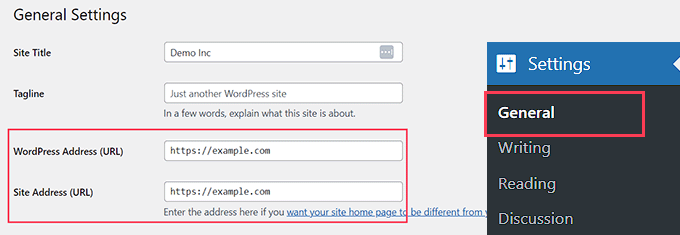
Adresy URL można również zmienić za pomocą pliku wp-config.php. Przydaje się to, jeśli nie możesz uzyskać dostępu do obszaru administracyjnego WordPress z powodu błędu zbyt wielu przekierowań.
Po prostu dodaj te dwie linie do twojego pliku wp-config.php:
1 2 | define('WP_HOME','http://example.com');define('WP_SITEURL','http://example.com'); |
Nie zapomnij zastąpić example.com nazwą twojej domeny.
Należy również pamiętać, że wyszukiwarki traktują www.example.com i example.com jako dwie różne lokalizacje (zobacz www vs non-www – która z nich jest lepsza dla SEO?).
Jeśli twoja witryna jest indeksowana z prefiksem www, musisz odpowiednio dodać nazwę domeny.
Zmiana katalogu przesyłania za pomocą pliku wp-config.php
Domyślnie WordPress przechowuje wszystkie przesłane przez ciebie pliki multimedialne w katalogu/wp-content/uploads/.
Jeśli chcesz przechowywać twoje pliki multimedialne w innej lokalizacji, możesz dodać ten wiersz kodu w pliku wp-config.php:
1 | define( 'UPLOADS', 'wp-content/media' ); |
Należy pamiętać, że ścieżka katalogu uploads jest względna w stosunku do ABSPATH automatycznie ustawionej w WordPress. Dodanie tutaj bezwzględnej ścieżki nie zadziała.
Więcej informacji można znaleźć w naszym szczegółowym przewodniku na temat zmiany domyślnej lokalizacji przesyłania multimediów w WordPress.
Wyłącz automatyczne aktualizacje w WordPress
WordPress ma domyślnie włączone automatyczne aktualizacje. Dzięki temu witryny WordPress są automatycznie aktualizowane, gdy dostępna jest drobna aktualizacja.
Na przykład, jeśli twoja witryna korzysta z WordPress 6.6 i zostanie wydana aktualizacja 6.6.1 z poprawkami błędów w zabezpieczeniach, to WordPress automatycznie zainstaluje aktualizację.
Jednak po wydaniu WordPress 6.7 zostaniesz poproszony o zainicjowanie aktualizacji.
Podczas gdy automatyczne aktualizacje mają kluczowe znaczenie dla zabezpieczenia, wielu użytkowników obawia się, że mogą one również zepsuć ich witrynę internetową, czyniąc ją niedostępną.
Dodanie tego pojedynczego wiersza kodu do pliku wp-config.php spowoduje wyłączenie wszystkich automatycznych aktualizacji na twojej witrynie WordPress:
1 | define( 'WP_AUTO_UPDATE_CORE', false ); |
Zobacz nasz poradnik jak wyłączyć automatyczne aktualizacje w WordPress, aby uzyskać więcej informacji.
Ograniczenie wersji wpisów w WordPressie
WordPress posiada wbudowane funkcje automatycznego zapisywania i wersji. Zobacz nasz poradnik na temat cofania zmian w WordPressie za pomocą wersji wpisów.
Wersje zajmują niewiele miejsca na większości witryn internetowych. Zauważyliśmy jednak znaczny wzrost rozmiaru kopii zapasowej bazy danych w przypadku niektórych większych witryn internetowych.
Jeśli prowadzisz dużą witrynę internetową, możesz ograniczyć liczbę wersji, które chcesz przechowywać w bazie danych.
Wystarczy dodać tę linię kodu do twojego pliku wp-config.php, aby ograniczyć liczbę wersji przechowywanych dla wpisu:
1 | define( 'WP_POST_REVISIONS', 3 ); |
Zastąp 3 liczbą wersji, które chcesz zapisać.
WordPress będzie teraz automatycznie odrzucał starsze wersje. Twoje starsze wersje wpisów są jednak nadal przechowywane w bazie danych. Zobacz nasz poradnik jak usunąć stare wersje wpisów w WordPress.
Film instruktażowy
Jeśli chcesz zobaczyć bardziej wizualną instrukcję, sprawdź nasz poradnik na YouTube poniżej:
Następne kroki, aby wzmocnić twoje umiejętności WordPress
Teraz, gdy już wiesz, jak edytować plik `wp-config.php`, możesz być ciekawy, co jeszcze możesz modyfikować, aby Twoja witryna była jeszcze lepsza. Zebraliśmy kilka naszych ulubionych poradników, aby pomóc ci w dalszym odkrywaniu i doskonaleniu twoich umiejętności.
Każdy z nich zawiera praktyczne wskazówki, z których sami korzystaliśmy podczas zarządzania witrynami WordPress:
- Jak skonfigurować logi błędów WordPressa w WP-Config?
- Najbardziej pożądane porady, triki i hacki WordPress
- Najbardziej przydatne sztuczki .htaccess dla WordPress
- Najbardziej przydatne skróty klawiaturowe WordPress oszczędzające czas
Mamy nadzieję, że ten artykuł pomógł ci dowiedzieć się, jak edytować plik wp-config.php w WordPress i wszystkie fajne rzeczy, które możesz z nim zrobić. Możesz również zapoznać się z naszym artykułem na temat zabezpieczania hasłem katalogu administratora WordPress lub naszymi wskazówkami dotyczącymi korzystania z paska administratora WordPress.
If you liked this article, then please subscribe to our YouTube Channel for WordPress video tutorials. You can also find us on Twitter and Facebook.





Sean Hodge
I believe you should not put any custom rules below the ABSPATH / vars bit down at the bottom, but can you put stuff in any order above those lines?
I’ve got some time on my hands, so I’ve been doing just that, moving stuff around the wp-config file, and removing all the extra fluff between comments. I now know what it all does, and have just left a simple title above each group of rules, such as
/**
* Authentication Unique Keys and Salts.
*/
All the rest of the info about Salts, and debugging etc, is now gone, the stuff that usually appears in green.
What I also did was move the $table_prefix above the Salts, right under the rest of the database info.
I’ve done this all because when I do go in there to modify actual rules, I have to wade my way through what is now useless info, to me.
So far, nothing has exploded, but I thought to ask anyway.
WPBeginner Support
You can change the order of the other content in that file if you wanted, we would warn to be careful when moving that you don’t remove part of the code and normally you should not need to edit your wp-config file.
Admin
Priyanshu Nandi
Which code lines l have to type to increase
Max_input_vars value in this file
WPBeginner Support
That would require changes to your htaccess or a different file, we would recommend reaching out to your host for assistance with what you’re wanting to do.
Admin
WPBeginner Support
Thank you, glad you liked our article
Admin
S.s. Brar
Great article. A must have information for WP admins.
Thanks to Syed and His Team.
WPBeginner Support
Glad our article could be helpful
Admin
Mister No
Hi there, great article. I’m having a problem with my website mobile version. When I try to open it on the mobile phone it says “This site is experiencing technical difficulties”.
What should I do to make my site work again properly?
Thanks in advance
WPBeginner Support
There are a few possible reasons you could be receiving that error, for a starting point you would want to take a look at our guide here: https://www.wpbeginner.com/beginners-guide/beginners-guide-to-troubleshooting-wordpress-errors-step-by-step/
Admin
Paul
Syed, all of a sudden, I can’t upload images (message: missing a temporary folder). Tried to log into WordPress to check support blogs and my username is not recognised.
WPBeginner Support
For that error, you would want to take a look at our guide here: https://www.wpbeginner.com/wp-tutorials/how-to-fix-missing-a-temporary-folder-error-in-wordpress/
Admin
Gale
I am a newbie at wordpress. I uploaded the files via Filezilla and got everything configured. Now how exactly do I actually access my new wp-blog site?
Wp is in the root (public_html) of my website. There were several other file folders that came with Wp. Do I upload them into the public_html folder as well?
WPBeginner Support
If you’re installing WordPress using FTP then you would want to take a look at our guide here:
https://www.wpbeginner.com/how-to-install-wordpress/#installftp
Once the site is set up you would want to go to your login page and log in with the user you created in the installation process:
https://www.wpbeginner.com/beginners-guide/how-to-find-your-wordpress-login-url/
Admin
Esther
Hi, I found out when I was installing WordPress, it was installed in subdirectory Wp and has a result my website can’t go live, my web host said I have to uninstall and install again and I should leave the Wp in the Installation panel blank, my problem is that I have designed the website only to go live and once I uninstall everything will be wiped off, what do I about it, Is there a way to avoid that?
WPBeginner Support
If your host requires the site to be in the main directory, you would want to follow the steps in the WordPress coded to move directories on your existing server
Admin
Mina
Hi,
Thank you for the useful article.
I’m new to this file and I have a basic question. I changed the cache plugin of my site and I need to change the line about it at the beginning of the file to override details of the previous plugin.
Once my file is updated, can I upload it while the cache plugin is activated, and deactivate/reactivate it just after, or do I have to deactivate the plugin before uploading the new wp-config file ?
Thanks for your help.
WPBeginner Support
If your plugin is requiring you to edit your wp-config file you would normally want to edit the wp-config file before activating your new plugin.
Admin
Tiar
hi, i have a wordpress site, i want edit my wordpress site in local, but when i already backup and run my wordpress in local. the page is full of white. can you help me ? im beginner in wordpress
WPBeginner Support
For moving your live site to a local installation, you would want to use the guide here: https://www.wpbeginner.com/wp-tutorials/how-to-move-live-wordpress-site-to-local-server/
Admin
Arthur
I have updated my website (lostkatanning.com) o WP 5.1 (the Gutenberg update) but now, when working on pages or posts it has slowed right down to a crawl and takes forever to respond to even a single key touch. I have tried numerous things from various websites but nothing seems to work. It is starting to do my head in! Any ideas on how to get my speed back?
WPBeginner Support
Hi Arthur,
You can disable the Gutenberg by installing the classic editor plugin to temporarily solve the problem.
Admin
mostafa
Hi
I have a wordpress site. Today I realized my wp-config.php file has been removed for no reason (The reason is not important for me right now).
I want to know what happens if I create another wp-config.php file in the root directory of my website by renaming the wp-config-sample.php file again and set the database name blah blah blah
does it affect my pages and posts? How about the users who have signed up to my website? does it remove them? If the answer is yes, isn’t it better for me to restore backup? The only problem for restoring backup is that it is for two days ago and I posted a new content yesterday and I will miss it.
Thank you very much in advance
WPBeginner Support
Your user and post information is in the database so that information shouldn’t be affected, as long as you connect it to your correct database then there shouldn’t be any change.
Admin
Deepak
Hello,
How do I edit wp-config for setting other smtp using WP smtp plugin ?
Plugin says, “The password is stored in plain text. We highly recommend you setup your password in your WordPress configuration file for improved security; to do this add the lines below to your wp-config.phpfile.
define( ‘WPMS_ON’, true ); define( ‘WPMS_SMTP_PASS’, ‘your_password’ ); ”
Where do I exactly add the code ? It don’t shown in tutorial video or article of Wpbeginner.
WPBeginner Support
Hi Deepak,
You can add this code just before the line that says ‘That’s all, stop editing! Happy blogging’ in your wp-config.php file.
Admin
Riyaz
Thank you for sharing this article, it was simple and easy to understand.
Gaurav Bhatnagar
Hi, I just updated my WordPress to new version manually using FileZilla. My website was working. But then, I did some update inside wp-config.php file. Now the size of that file on server has become ‘0’. Even if I update it from local PC, it still remains ‘0’. What should I do? Now website is not working. I am getting – HTTP Error 500
WPBeginner Support
Hi Gaurav,
You can download a fresh copy of WordPress and extract it on your computer. Inside it you will find a wp-config-sample.php file. You can upload this file to your server and rename it to wp-config.php. You will now need to edit wp-config.php file and enter your WordPress database information.
Admin
Gaurav Bhatnagar
It worked. Thank you.
Greg Bryant
I have an intranet-based wordpress site that I’m setting up. I’m having issues with the proxy configuration in wp-config.php. I’ve tried about everything I know and I still keep getting ‘Proxy Authentication Required” errors.
define(‘WP_PROXY_HOST’, ‘https://proxy.domain.com’);
define(‘WP_PROXY_PORT’, ‘3128’);
define(‘WP_PROXY_USERNAME’, ‘domain\\username’);
define(‘WP_PROXY_PASSWORD’, ‘xxxxxx’);
define(‘WP_PROXY_BYPASS_HOSTS’, ‘localhost’);
Our internal wordpress site can detect that there are new versions of plug-ins but when I try to update I get the proxy authentication error. I’ve tried the variables above with https, http, just proxy.domain.com, the username escaping the \, not escaping the backslash, etc. I looked at the code in class-wp-http-proxy.php and it appears the authentication connects the username with a : and then the password like the http(s)_proxy environment variable. I’ve tried local host for the bypass and an empty string. Our Windows domain uses an file; is there a place to specify this?
I get the same proxy authentication errors trying to download anything from the internal wordpress site.
Error occurred. Something may be wrong with WordPress.org or this server’s configuration. If you continue to have problems, please try the support forums. (WordPress could not establish a secure connection to WordPress.org. Please contact your server administrator.) in /var/www/epkb.mw-process-ctrl.com/public_html/wp-admin/includes/plugin-install.php on line 168
I’m also having an issue with php’s file_get_contents if that’s something wordpress uses. cURL works fine.
Any ideas?
Thanks
WPBeginner Support
Hi Greg,
Please make sure that your localhost environment has curl extension installed and enabled for PHP. Please see our guide on how to fix secure connection error in WordPress for more details.
Admin
Greg Bryant
I have curl installed.
It lists ipV6 as yes but I have ipV6 disabled since our network doesn’t support it.
I think the problem is authenticating with our proxy. On the server I use:
(the \ is escaped when setting the env variables). Above is my wp-content proxy settings.
I’m using ufw for my firewall and have tried with it enabled & disabled with the same results.
Any other ideas?
Thanks
WPBeginner Support
Hi Greg,
We are not sure. You can post on WordPress.org forums may be someone who has faced similar situation can help out.
Jon M
Do the changes take effect immediately after saving the new wp-config file?
WPBeginner Support
Hey Jon,
Yes, they are effectively immediately. However, if you are editing wp-config file in a text editor on your computer, then simply saving your changes may not change the wp-config.php file on your server. You will need to upload the changed wp-config.php file back to your server for changes to take effect.
Admin
Andy
What’s the best way to upload the changed wp-config.php file back to the server?
Can the tutorial be updated with how to upload the adjusted config file? The tutorial seems to be incomplete for the (relative) novice
WPBeginner Support
Hi Andy,
We have linked to our article on how to use FTP to upload WordPress files. It also applies to editing your wp-config.php file. You can simply download your wp-config.php file to your computer using FTP. Edit it to make your desired changes and then upload it back using the same FTP client.
Hope this helps.
ayush
I did something silly , i removed the www part from wp site url under Setting-General . Now admin panel is getting redirected to wordpress one. i used your steps to copy both lines with modification and uploaded via ftp . No luck .Plz help
Boris
Excellent post. I am a newbie and learned a lot.
I have an issue with my site. It looks like I have been hacked. I ran WordFence scan and it caught a line of code in my wp-config.php file that it flagged as not belonging there. Following is the code:
My question is this. Can I remove the "@include…" from the file without screwing up the .php file.
Any guidance will be appreciated.
WPBeginner Support
Hi Boris,
Is the file part of the core WordPress software, a plugin, or a theme? If yes, then download a fresh copy of WordPress core, plugins, or theme the file belongs to and then upload the new file.
You can also download the file to your computer before editing the code as a backup. If anything goes wrong you can then upload it back.
Admin
Saud Razzak
Great post, glad I read.
Steph
I’m having problems accessing site. I debugged and am getting a list of problems but most seem to come back to this one:
“Notice: get_settings is deprecated since version 2.1.0!
Use get_option() instead. in /usr/local/pem/vhosts/xxxxxx/webspace/siteapps/WordPress-xxxxx/htdocs/wp-includes/functions.php on line 3752″
But line 3752 reads:
” trigger_error( sprintf( __(‘%1$s is deprecated since version %2$s! Use %3$s instead.’), $function, $version, $replacement ) ); ”
So i’ve no idea what to replace. I’m sure this is 101 stuff to you, but I’m really confused!! I would really appreciate your advice, thank you.
Steph
Found your section on disabling plugins – which was a great help as the the site is now viewable whilst I try to resolve. This is the message I see now when logged in WP Admin
” Catchable fatal error: Argument 1 passed to Genesis_Admin_CPT_Archive_Settings::__construct() must be an instance of stdClass, instance of WP_Post_Type given, called in /usr/local/pem/vhosts/xxxxxx/webspace/siteapps/WordPress-xxxxxx/htdocs/wp-content/themes/genesis/lib/admin/menu.php on line 122 and defined in /usr/local/pem/vhosts/xxxxxx/webspace/siteapps/WordPress-xxxxxx/htdocs/wp-content/themes/genesis/lib/admin/cpt-archive-settings.php on line 38 ”
Am in a spot of bother and could really use your help – thank you!
WPBeginner Support
Hey Steph,
Try updating your Genesis child theme. Connect to your website using FTP and download your child theme as a backup. After that delete child theme folder from your website.
Next, download a fresh copy of the theme and install it. If this doesn’t work, then try updating Genesis core itself.
Admin
Hell Men
If i delete salt key can i decrypt wordpress password ?
Sean
Hi,
I did something silly and now can’t get my site to work. Basically I kept my site live at said URL example.com and created a folder where I built the WordPress site example.com/Wordpress. However when I went to put the wordpress site into the root folder after backing everything up I forgot to change the site URL in the dashboard. i basically then removed my entire site and copied everything from the wordpress site into the root URL. It didn’t work – so I thought I would remove everything and restore my site as it was with both the wordpress and the normal site working.
However once I restored all the files the wordpress site now errors with 404 Page not found and I can’t login into the dashboard either.
Any idea how I can restore this? I think it is looking in the root directory and WordPress folder for the site or something similar and it’s causing the error – but how do I fix it?
Thanks
Sean
WPBeginner Support
Hi Sean,
You can update WordPress URLs by adding this code to your wp-config.php file:
define('WP_HOME','http://example.com');define('WP_SITEURL','http://example.com');
Admin
Dan
Hello i would like to have it when i upload an image it gets uploaded to my cloud from wordpress.
i got a url & api key.
Any suggestions would be cool. thanks.
Eeswar Reddy
Best site for WordPress Beginners. Solved my blog problem simply. Thank u so much Sir…
WPBeginner Support
You are welcome Don’t forget to join us on Twitter for more WordPress tips and tutorials.
Don’t forget to join us on Twitter for more WordPress tips and tutorials.
Admin
Karl
Nice instructions, as far as they go. However, I know it is ALSO possible to edit wp-config.php directly through WordPress’ Admin area but it seems to be a closely guarded secret as to HOW to actually do this. I do not have FTP access to my site so I have to use some other method and I’d rather not go chasing down the rabbit hole of trying out various flaky plugins until I find one that actually works. Your assistance as to what menu drill-down to explore in WordPress Admin would be greatly appreciated.
WPBeginner Support
It is not a good idea to edit wp-config.php file inside WordPress admin area. One tiny mistake and you will be locked out of your WordPress site. If you do not have FTP access, you can try editing it via cPanel’s file manager.
Admin
Angela
I don’t want to sound stupid, but please help me understand… are the wp-config.php changes supposed to be made on my Mac or on the host for my website. They are two different machines.
Please help! I keep making changes to my web site and all of a sudden they just do not ‘take’.
Best regards,
Angela
WPBeginner Support
You can make changes to wp-config.php file using an FTP client. It allows you to edit files on your web server. After connecting to your website using an FTP client, you need to locate wp-config.php file and download it to your computer. Make changes it to it using a text editor like TextEdit. Save your changes and then upload the file back to your web server using the FTP client.
Admin
Sharron
Ok, so I added define(‘WP_ALLOW_REPAIR’, true); to my downloaded wp config file with notepad. Now what?
Ray
Once you have done that, you can see the settings by visiting this URL on your blog:
yoursite.com/wp-admin/maint/repair.php
You have 2 buttons
1st – Repair Database
2nd – Repair and Optimize Database
I suggest u click the 1st one and wait for the process to finish.
John Johnson
CODA is an FTP Client as well. Correct?
PiNo
Hi,
For security I add to my .htaccess
<files wp-config.php>
order allow,deny
deny from all
</files>
Kind regards